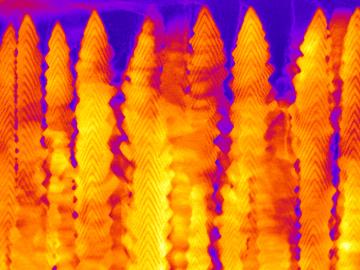
Filter News
Area of Research
- (-) Fusion Energy (5)
- (-) Materials (53)
- (-) Materials for Computing (9)
- (-) National Security (35)
- Advanced Manufacturing (5)
- Biology and Environment (35)
- Computational Biology (1)
- Computational Engineering (1)
- Computer Science (5)
- Energy Science (41)
- Fuel Cycle Science and Technology (1)
- Fusion and Fission (30)
- Isotope Development and Production (1)
- Isotopes (4)
- Neutron Science (103)
- Nuclear Science and Technology (25)
- Quantum information Science (2)
- Sensors and Controls (1)
- Supercomputing (100)
News Type
News Topics
- (-) Advanced Reactors (4)
- (-) Artificial Intelligence (20)
- (-) Clean Water (2)
- (-) Computer Science (35)
- (-) Machine Learning (15)
- (-) Neutron Science (33)
- (-) Nuclear Energy (19)
- (-) Security (11)
- 3-D Printing/Advanced Manufacturing (21)
- Big Data (5)
- Bioenergy (13)
- Biology (8)
- Biomedical (7)
- Biotechnology (1)
- Buildings (4)
- Chemical Sciences (30)
- Composites (6)
- Coronavirus (5)
- Critical Materials (8)
- Cybersecurity (19)
- Energy Storage (29)
- Environment (18)
- Exascale Computing (2)
- Frontier (2)
- Fusion (11)
- Grid (8)
- High-Performance Computing (7)
- Isotopes (12)
- ITER (1)
- Materials (62)
- Materials Science (61)
- Mathematics (1)
- Microscopy (20)
- Molten Salt (2)
- Nanotechnology (33)
- National Security (35)
- Partnerships (15)
- Physics (24)
- Polymers (15)
- Quantum Computing (3)
- Quantum Science (13)
- Simulation (1)
- Space Exploration (2)
- Summit (4)
- Transportation (13)
Media Contacts

A team led by the Department of Energy’s Oak Ridge National Laboratory synthesized a tiny structure with high surface area and discovered how its unique architecture drives ions across interfaces to transport energy or information.

Temperatures hotter than the center of the sun. Magnetic fields hundreds of thousands of times stronger than the earth’s. Neutrons energetic enough to change the structure of a material entirely.

Scientists at the Department of Energy Manufacturing Demonstration Facility at ORNL have their eyes on the prize: the Transformational Challenge Reactor, or TCR, a microreactor built using 3D printing and other new approaches that will be up and running by 2023.

Research by an international team led by Duke University and the Department of Energy’s Oak Ridge National Laboratory scientists could speed the way to safer rechargeable batteries for consumer electronics such as laptops and cellphones.

In the race to identify solutions to the COVID-19 pandemic, researchers at the Department of Energy’s Oak Ridge National Laboratory are joining the fight by applying expertise in computational science, advanced manufacturing, data science and neutron science.

An international team of researchers has discovered the hydrogen atoms in a metal hydride material are much more tightly spaced than had been predicted for decades — a feature that could possibly facilitate superconductivity at or near room temperature and pressure.

A typhoon strikes an island in the Pacific Ocean, downing power lines and cell towers. An earthquake hits a remote mountainous region, destroying structures and leaving no communication infrastructure behind.

Scientists at have experimentally demonstrated a novel cryogenic, or low temperature, memory cell circuit design based on coupled arrays of Josephson junctions, a technology that may be faster and more energy efficient than existing memory devices.

Researchers at ORNL have developed a quantum chemistry simulation benchmark to evaluate the performance of quantum devices and guide the development of applications for future quantum computers.

Students often participate in internships and receive formal training in their chosen career fields during college, but some pursue professional development opportunities even earlier.


